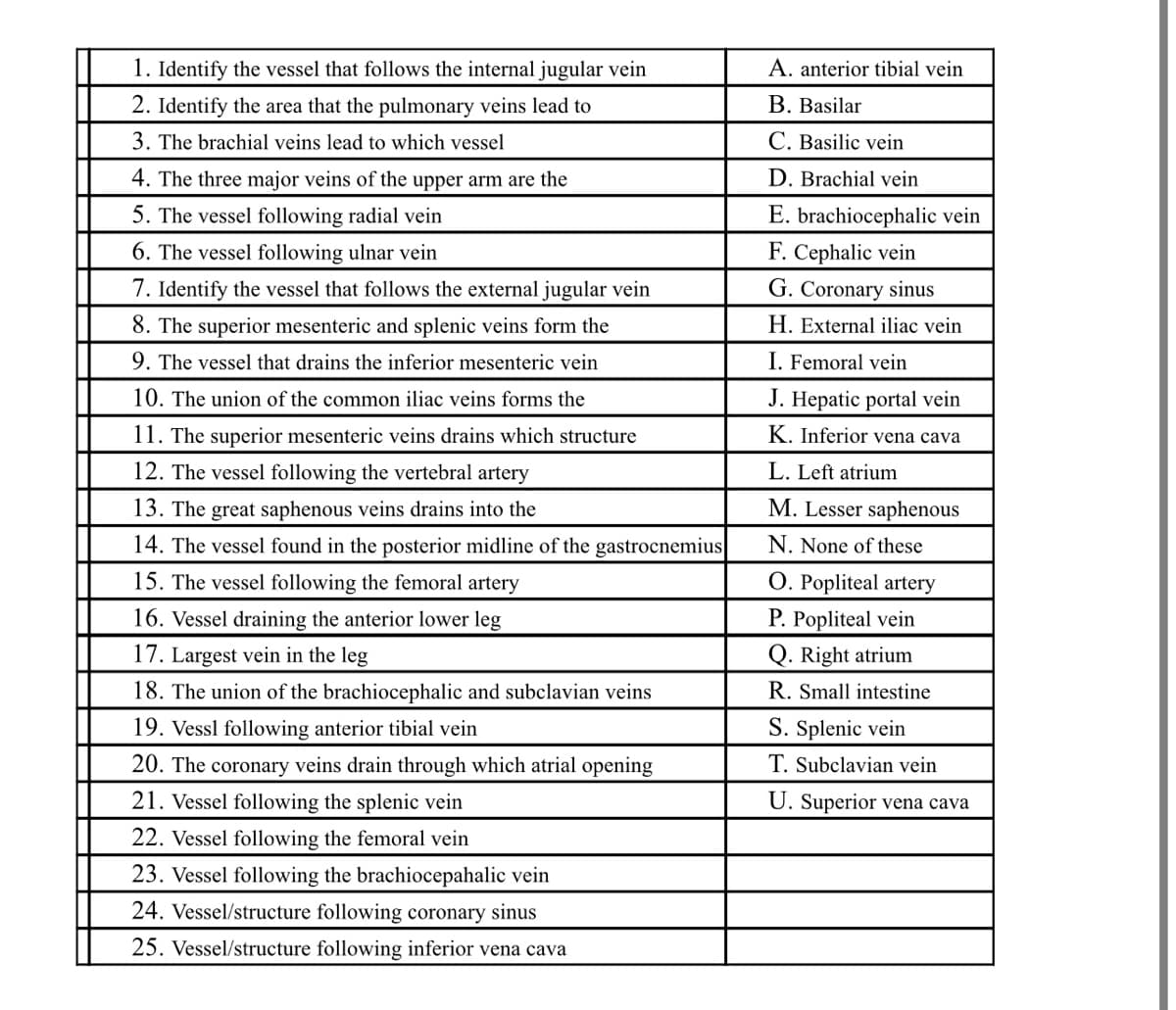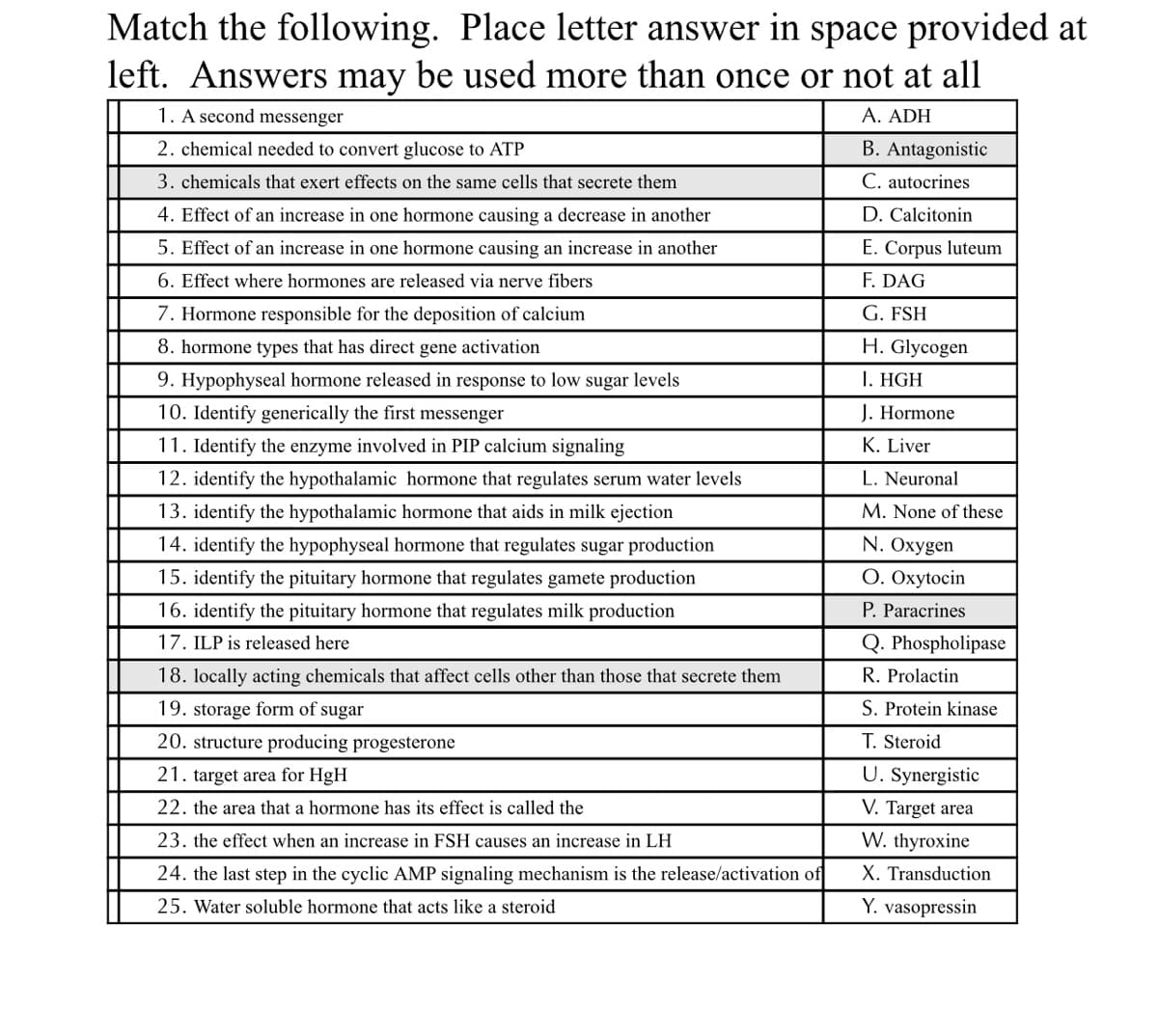1. Identify the vessel that follows the internal jugular vein A. anterior tibial vein 2. Identify the area that the pulmonary veins lead to B. Basilar 3. The brachial veins lead to which vessel C. Basilic vein 4. The three major veins of the upper arm are the D. Brachial vein E. brachiocephalic vein F. Cephalic vein G. Coronary sinus 5. The vessel following radial vein 6. The vessel following ulnar vein 7. Identify the vessel that follows the external jugular vein 8. The superior mesenteric and splenic veins form the H. External iliac vein 9. The vessel that drains the inferior mesenteric vein I. Femoral vein 10. The union of the common iliac veins forms the J. Hepatic portal vein 11. The superior mesenteric veins drains which structure K. Inferior vena cava 12. The vessel following the vertebral artery L. Left atrium 13. The great saphenous veins drains into the M. Lesser saphenous 14. The vessel found in the posterior midline of the gastrocnemius N. None of these 15. The vessel following the femoral artery O. Popliteal artery 16. Vessel draining the anterior lower leg P. Popliteal vein 17. Largest vein in the leg Q. Right atrium 18. The union of the brachiocephalic and subclavian veins R. Small intestine 19. Vessl following anterior tibial vein S. Splenic vein 20. The coronary veins drain through which atrial opening T. Subclavian vein 21. Vessel following the splenic vein U. Superior vena cava 22. Vessel following the femoral vein 23. Vessel following the brachiocepahalic vein 24. Vessel/structure following coronary sinus 25. Vessel/structure following inferior vena cava
1. Identify the vessel that follows the internal jugular vein A. anterior tibial vein 2. Identify the area that the pulmonary veins lead to B. Basilar 3. The brachial veins lead to which vessel C. Basilic vein 4. The three major veins of the upper arm are the D. Brachial vein E. brachiocephalic vein F. Cephalic vein G. Coronary sinus 5. The vessel following radial vein 6. The vessel following ulnar vein 7. Identify the vessel that follows the external jugular vein 8. The superior mesenteric and splenic veins form the H. External iliac vein 9. The vessel that drains the inferior mesenteric vein I. Femoral vein 10. The union of the common iliac veins forms the J. Hepatic portal vein 11. The superior mesenteric veins drains which structure K. Inferior vena cava 12. The vessel following the vertebral artery L. Left atrium 13. The great saphenous veins drains into the M. Lesser saphenous 14. The vessel found in the posterior midline of the gastrocnemius N. None of these 15. The vessel following the femoral artery O. Popliteal artery 16. Vessel draining the anterior lower leg P. Popliteal vein 17. Largest vein in the leg Q. Right atrium 18. The union of the brachiocephalic and subclavian veins R. Small intestine 19. Vessl following anterior tibial vein S. Splenic vein 20. The coronary veins drain through which atrial opening T. Subclavian vein 21. Vessel following the splenic vein U. Superior vena cava 22. Vessel following the femoral vein 23. Vessel following the brachiocepahalic vein 24. Vessel/structure following coronary sinus 25. Vessel/structure following inferior vena cava
Anatomy & Physiology
1st Edition
ISBN:9781938168130
Author:Kelly A. Young, James A. Wise, Peter DeSaix, Dean H. Kruse, Brandon Poe, Eddie Johnson, Jody E. Johnson, Oksana Korol, J. Gordon Betts, Mark Womble
Publisher:Kelly A. Young, James A. Wise, Peter DeSaix, Dean H. Kruse, Brandon Poe, Eddie Johnson, Jody E. Johnson, Oksana Korol, J. Gordon Betts, Mark Womble
Chapter20: The Cardiovascular System: Blood Vessels And Circulation
Section: Chapter Questions
Problem 21RQ: Which of the following statements is true? The left and right common carotid arteries both branch...
Related questions
Question
100%

Transcribed Image Text:1. Identify the vessel that follows the internal jugular vein
A. anterior tibial vein
2. Identify the area that the pulmonary veins lead to
B. Basilar
3. The brachial veins lead to which vessel
C. Basilic vein
4. The three major veins of the upper arm are the
D. Brachial vein
5. The vessel following radial vein
E. brachiocephalic vein
F. Cephalic vein
6. The vessel following ulnar vein
7. Identify the vessel that follows the external jugular vein
G. Coronary sinus
8. The superior mesenteric and splenic veins form the
H. External iliac vein
9. The vessel that drains the inferior mesenteric vein
I. Femoral vein
10. The union of the common iliac veins forms the
J. Hepatic portal vein
11. The superior mesenteric veins drains which structure
K. Inferior vena cava
12. The vessel following the vertebral artery
L. Left atrium
13. The great saphenous veins drains into the
M. Lesser saphenous
14. The vessel found in the posterior midline of the gastrocnemius
N. None of these
15. The vessel following the femoral artery
O. Popliteal artery
16. Vessel draining the anterior lower leg
P. Popliteal vein
17. Largest vein in the leg
Q. Right atrium
18. The union of the brachiocephalic and subclavian veins
R. Small intestine
19. Vessl following anterior tibial vein
S. Splenic vein
20. The coronary veins drain through which atrial opening
T. Subclavian vein
21. Vessel following the splenic vein
U. Superior vena cava
22. Vessel following the femoral vein
23. Vessel following the brachiocepahalic vein
24. Vessel/structure following coronary sinus
25. Vessel/structure following inferior vena cava

Transcribed Image Text:Match the following. Place letter answer in space provided at
left. Answers may be used more than once or not at all
1. A second messenger
A. ADH
2. chemical needed to convert glucose to ATP
B. Antagonistic
3. chemicals that exert effects on the same cells that secrete them
C. autocrines
4. Effect of an increase in one hormone causing a decrease in another
D. Calcitonin
5. Effect of an increase in one hormone causing an increase in another
E. Corpus luteum
6. Effect where hormones are released via nerve fibers
F. DAG
7. Hormone responsible for the deposition of calcium
G. FSH
8. hormone types that has direct gene activation
H. Glycogen
9. Hypophyseal hormone released in response to low sugar levels
I. HGH
10. Identify generically the first messenger
J. Hormone
11. Identify the enzyme involved in PIP calcium signaling
K. Liver
12. identify the hypothalamic hormone that regulates serum water levels
L. Neuronal
13. identify the hypothalamic hormone that aids in milk ejection
M. None of these
14. identify the hypophyseal hormone that regulates sugar production
N. Oxygen
15. identify the pituitary hormone that regulates gamete production
O. Oxytocin
16. identify the pituitary hormone that regulates milk production
P. Paracrines
17. ILP is released here
Q. Phospholipase
18. locally acting chemicals that affect cells other than those that secrete them
R. Prolactin
19. storage form of sugar
S. Protein kinase
20. structure producing progesterone
T. Steroid
21. target area for HgH
U. Synergistic
22. the area that a hormone has its effect is called the
V. Target area
23. the effect when an increase in FSH causes an increase in LH
W. thyroxine
24. the last step in the cyclic AMP signaling mechanism is the release/activation of
X. Transduction
25. Water soluble hormone that acts like a steroid
Y. vasopressin
Expert Solution
This question has been solved!
Explore an expertly crafted, step-by-step solution for a thorough understanding of key concepts.
This is a popular solution!
Trending now
This is a popular solution!
Step by step
Solved in 2 steps

Knowledge Booster
Learn more about
Need a deep-dive on the concept behind this application? Look no further. Learn more about this topic, biology and related others by exploring similar questions and additional content below.Recommended textbooks for you

Anatomy & Physiology
Biology
ISBN:
9781938168130
Author:
Kelly A. Young, James A. Wise, Peter DeSaix, Dean H. Kruse, Brandon Poe, Eddie Johnson, Jody E. Johnson, Oksana Korol, J. Gordon Betts, Mark Womble
Publisher:
OpenStax College

Basic Clinical Lab Competencies for Respiratory C…
Nursing
ISBN:
9781285244662
Author:
White
Publisher:
Cengage

Fundamentals of Sectional Anatomy: An Imaging App…
Biology
ISBN:
9781133960867
Author:
Denise L. Lazo
Publisher:
Cengage Learning

Anatomy & Physiology
Biology
ISBN:
9781938168130
Author:
Kelly A. Young, James A. Wise, Peter DeSaix, Dean H. Kruse, Brandon Poe, Eddie Johnson, Jody E. Johnson, Oksana Korol, J. Gordon Betts, Mark Womble
Publisher:
OpenStax College

Basic Clinical Lab Competencies for Respiratory C…
Nursing
ISBN:
9781285244662
Author:
White
Publisher:
Cengage

Fundamentals of Sectional Anatomy: An Imaging App…
Biology
ISBN:
9781133960867
Author:
Denise L. Lazo
Publisher:
Cengage Learning

